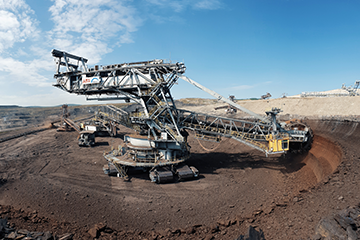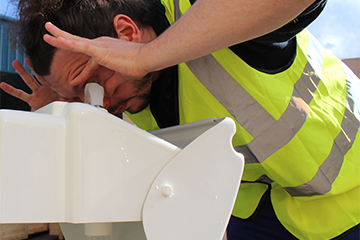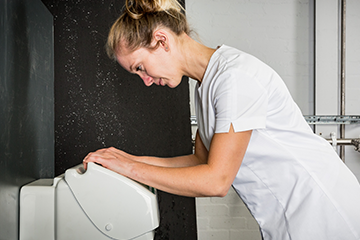Enquiry List () (0)
- 10 Mar 2022
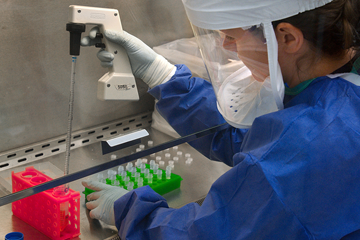
How to Use a Safety Shower in the Lab
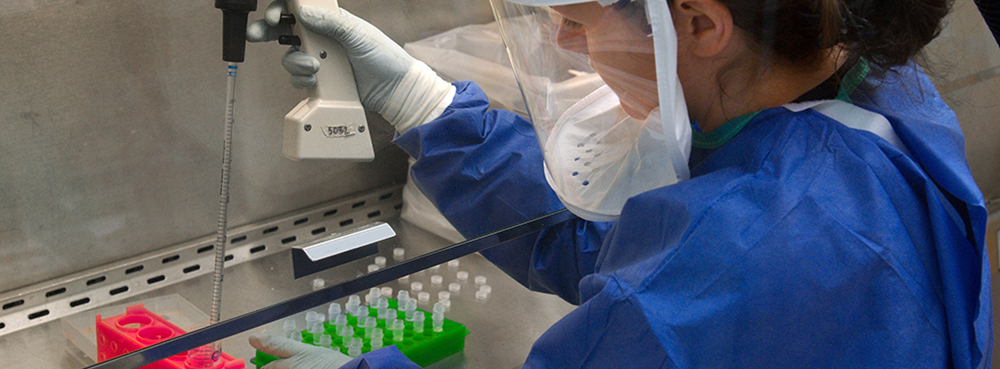
Laboratories are dynamic environments, rich with innovation but also inherent risks. The daily handling of chemicals means that accidents, though rare, can have serious consequences.
Emergency safety showers and eyewash stations provide the first line of defence from chemical splashes and burns, or when damaging dust or small particles get in the eye. Knowing exactly how to use them and where they’re located can be the difference between a minor incident and a severe injury.
Examples of Laboratory Incidents
A laboratory incident at UC Berkeley in 2009 caused severe chemical burns to a student. A few drops of the corrosive chemical oleylamine fell onto a researcher’s uncovered forearm. When he realised what had happened, he went to the restroom and washed his arm with soap and water for about a minute. Unfortunately, oleylamine is corrosive and hard to wash off the skin. The Safety Data Sheet (SDS) recommends immediate flushing with plenty of water for a minimum of 15 minutes. Over the next 24 hours, delayed burns appeared on the student’s arm, eventually requiring hospital treatment.
Another lab incident at the same university proved that even the smallest quantities of chemicals may cause significant harm when something goes wrong. A graduate researcher was synthesising 1 gram of diazonium perchlorate crystals, a chemical compound known for its explosive and unstable properties. He was using a metal spatula to transfer the perchlorate salts into a porcelain funnel when the chemical exploded. It sent tiny shards of porcelain everywhere, shattering the researcher’s glasses and scratching his cornea. A fellow researcher assisted the injured person with using the eyewash before heading to hospital for treatment.
What is a Safety Shower Used for in a Lab?
A safety shower is not for routine hygiene; its primary purpose is immediate, full-body decontamination following an accidental exposure to hazardous chemicals or materials.
In a laboratory setting, a safety shower is used to:
- Rapidly wash away chemicals: if chemicals splash onto a lab worker’s skin or clothing, the shower delivers a high volume of water instantly to dilute and flush away the hazardous substance. This action minimises the contact time between the chemical and the body.
- Prevent severe injuries: by quickly removing irritants, corrosives or toxic materials, the safety shower helps to prevent severe chemical burns and skin damage.
- Control reactions: for some reactive chemicals, a continuous flow of water can help to cool the substance and halt ongoing chemical reactions on the skin.
There are several styles of emergency showers suitable for laboratories. Use plumbed emergency safety shower stations when possible. Powder-coated pipework stands up well to corrosive and flammable chemicals. Various models are available when space is limited.
Where is the Safety Shower Located in a Lab?
In an emergency, every second counts. The safety standards EN15154 and ANSI/ISEA Z358.1-2014 govern where emergency showers are located in a lab. Regulation states that safety showers (and eyewash stations) should be accessible within 10 seconds' travel time from any potential hazard.
Safety showers should be strategically placed near areas where corrosive, toxic or hazardous chemicals are routinely handled, stored or transferred. This includes fume cupboards, chemical storage areas and experimental setups. They are typically located in an open, visible area, never hidden behind equipment or in obscure corners. The pathway to the shower should always be free of any clutter or tripping hazards.
Place the laboratory shower in a location where someone would be comfortable removing contaminated clothing. For additional privacy, modesty curtains are available. These also prevent water and contaminants from splashing the area around the shower.
Helpful hint: instruct all lab personnel to keep a change of loose-fitting clothes in the lab near the safety shower in case their lab coat and clothes become contaminated and need to be removed.
Showers should always be identified with prominent, universally recognised signage to ensure they are easily spotted, even under stressful conditions. Also, ensure that all electronic equipment in the general vicinity of the shower/eye wash fixture is protected, and drainage is available to catch the water when activated.
Note: For labs with special drainage requirements to prevent contamination of the water table, always adhere to the emergency safety shower and eyewash equipment standard operating procedures (SOPs) for activation.
Regular drills and familiarisation with the lab layout are essential to ensure all lab workers know the exact location of the nearest safety shower.
Requirements for Safety Showers and Eyewashes
Industries adopt EN15154 and ANSI/ISEA Z358.1-2014 standards for the design, performance, use and maintenance of emergency showers and eyewash equipment. They list specific requirements for water temperature, flow rate and other functionality for emergency safety showers and other safety equipment. The overall purpose is to ensure effective flushing of chemicals off the skin of an injured person.
- Water flow rate: an emergency safety shower must provide a minimum water flow of 76 litres per minute for at least 15 minutes. The minimum water flow rate for eye washes is 1.5 litres per minute for 15 minutes. If the unit is a combination eye and face wash, it must deliver 12 litres per minute. This ensures there is an adequate amount of water to dilute and flush away the chemical, but the water velocity is not so high that it damages the skin or eyes.
- Water temperature: EN15154 standards state that emergency safety shower water temperature should be in the tepid range of 16-38°C (60-100°F). If the water is too cold, a person may exit the shower early and may even suffer shock or hypothermia. If it is too hot, the heat may scald the person or open the pores of the skin, causing more severe chemical burns. It could also prevent them from holding their eyes open when using an eyewash for the entire time required to flush.
- Continuous flow: once activated, an emergency safety shower needs to flow without operator intervention. This provides time to remove contaminated clothing. It also allows the injured person to focus on flushing the affected area without worrying about keeping the water flowing.
- Enough space: eye wash stations should have enough space for a person to hold their eyelids open with their hands while rinsing their eyes.
- Adequate protection: protect eye wash nozzles from dust or other contaminants using covers. Under no circumstances should dirty water enter a user’s eyes during operation.
- Regular activation: standards require weekly testing of plumbed emergency shower and eyewash equipment. Activate the station per its instructions and flush to remove any sediment. Keep a record of any problems, malfunctions or broken parts and request maintenance if needed.
How to Use a Safety Shower in a Lab
In the unfortunate event of a chemical spill or splash, knowing how to use a safety shower in lab environments quickly and correctly is vital:
- React immediately: do not hesitate. The moment you’re exposed, move directly and quickly to the nearest safety shower. Every second of delay increases the potential for injury.
- Activate the shower: most lab safety showers are activated by pulling a handle or pushing a large lever. Ensure you activate it quickly and that the mechanism allows for hands-free operation once activated. The water flow should be immediate and continuous for a minimum of 15 minutes.
- Stand under the flow: position yourself directly under the showerhead, ensuring the water thoroughly drenches your entire body. Rotate slowly to allow the water to rinse all affected skin surfaces.
- Remove contaminated clothing: while standing under the running water, immediately begin removing all contaminated clothing, including shoes and socks.
- Flush for at least 15 minutes: continue flushing for a minimum of 15 minutes. This duration is crucial for effective dilution and removal of most hazardous substances. Refer to the Safety Data Sheet (SDS) for the specific chemical if you know it, as some substances may require longer flushing times.
- Seek medical attention: after the minimum 15-minute flush, always seek immediate medical attention, even if you feel the injury is minor. Some chemical exposures can cause delayed reactions.
Safe Handling Practices in Labs
Because most laboratory environments contain different types of chemicals, safe handling practices should always be at the top of everyone’s minds. Make sure the SDS for each chemical is accessible and that all lab personnel understand the associated risks and hazards. Standard operating procedures should be reviewed before conducting lab tasks.
Here are some useful tips for labs regarding safe handling:
- Always wear approved safety glasses during laboratory activities. Most standard prescription glasses are not designed to resist chemical splashes or shrapnel. Check with your eyewear provider to ensure your corrective lenses comply with the current ANSI Z87.1 requirement.
- Make sure someone is nearby when performing tasks involving hazardous or flammable materials. In case of vision impairment or chemical burns in an emergency, you may require assistance.
- Create and foster a culture of safety through learning and sharing. Encourage lab workers to regularly discuss and dissect incident reports and case studies from industry journals or other laboratories.
When internal incidents occur, be transparent and open during the safety investigation. Specify some time in every meeting and share findings with all lab workers. If necessary, provide additional training to prevent similar incidents in the future.
- Always follow simple lab best practices like using the appropriate PPE when working with chemicals or explosive chemicals inside a fume hood or behind a blast shield.
Emergency Safety Equipment for Laboratories
Hughes supplies an indoor safety shower and eye wash range designed for laboratories that meet the requirements of ANSI as well as the European Standard EN 15154 Part 1 for plumbed-in body showers. Stand-alone eye and face wash options include wall or pedestal mounts with several basin styles, depending on the application.
Laboratory showers feature easy-to-clean, powder-coated stainless-steel pipework. Options include:
We specialise in keeping people safe from workplace hazards like chemical splashes or burns. Our laboratory showers and emergency safety equipment meet the highest quality standards and comply with EN15154 and ANSI requirements.
Learn more about our laboratory safety showers or contact our technical experts for advice on your application.





